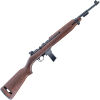kBob
Member
in my 20's a bud had a M1928 and a couple of 50 round drums as well as both 20 and 30 round sticks. We joked about it being his car gun as one needed a car to cart it about. Would have been great for a fixed defense where one would only carry it from storage to a firing position. Even a drum was emptied pretty fast on Full Auto. We thought it weighted more than another Buds Springfield M1A Rifle in an E2 stock and fitted with a bipod but never actually weighed the two. Actually I was very pleased at the time to have a M1 Carbine. Biggest problem I had with the Carbine was a girl friend that would shoot every last round of .30 carbine I had in the car when she would go shooting with me! One thing I noted in those days was that the Carbine penetrated more empty 55 gallon drums than most pistols.
-kBob
-kBob









